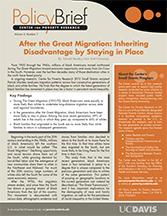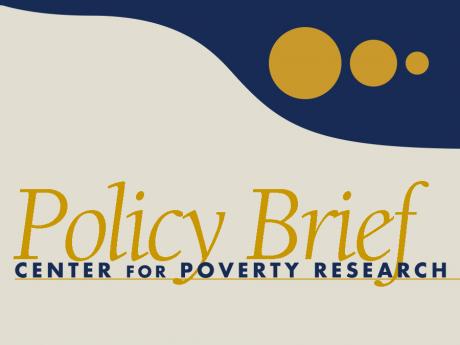After the Great Migration: Inheriting Disadvantage by Staying in Place
by Patrick Sharkey, New York University
From 1900 through the 1960s, millions of black Americans moved northward during The Great Migration toward economic opportunity and away from Jim Crow in the South. However, over the last few decades many of those destination cities in the north have fared poorly.
In ongoing research, Center for Poverty Research 2012 Small Grants recipient Patrick Sharkey analyzes migration patterns across four consecutive generations of black and white families. He finds that the degree to which the latest generation of black families has remained in place may be a factor in persistent racial inequality.
Key Findings
- During The Great Migration (1910-70), black Americans were equally or more likely than whites to undertake long-distance migration across state and regional boundaries.
- In the generation after the Great Migration, black Americans have been more likely to stay in place. Among the most recent generation, 69% of adults live in the county in which they grew up, compared to 45% of whites.
- Black families that originated in the South are no more likely than white families to return in subsequent generations.
Beginning in the early part of the 20th century and ending in the 1960s, millions of black Americans left the southern U.S. in what would be called “The Great Migration.” Declining opportunity and racial tension drove them out of the South, while growing demand for low-skilled labor and the emergence of new communities drew them to cities in the Northeast and Midwest. For much of the 20th century, large numbers of whites also left the South for some of the same economic reasons.
After the 1970s, this migration stream ended, and since then the South has drawn a growing stream of black Americans from the rest of the country. This movement is documented with census data, ethnographic evidence and stories from families who decided to return to the South or to move there for the first time. In that time whites have also migrated to the South, but are more likely to be living there for the first time in their lives.
This study finds that in the most recent generation, black Americans have in fact remained in place to a degree that is unique compared to the previous generation and also to whites of the same generation. This pattern of passing on geographic locations to the current generation can instead be described as “The Great Transmission,” and it has important implications for the demography of race and family migration, as well as for the persistence of racial inequality in the United States.
Movement across Four Generations
This study considers geographic migrations across four
consecutive generations of black and white American families. The
analysis is based on data collected in the Panel Study of Income
Dynamics (PSID), an ongoing longitudinal survey begun in 1968
that includes about 4,800 families.
The multigenerational approach analyzes migration as a process by which the geographic locations of families are linked together across generations. This approach is consistent with the literature on black American migration based on oral histories and qualitative research. Several prominent studies of black American migration focus on the importance of familial connections to place, which extends over long periods of time and across generations of family members.
By considering migration from one generation to the next, this analysis provides several new insights into ways in which the social or economic trajectories of both places and families are linked across time and generations. One implication of this research is that the migration patterns of each generation of family members cannot be understood as isolated from the migration patterns over the course of a family’s history.
Staying in Place
This study finds that among families in the PSID, black Americans
are actually less likely than whites to return to their families’
points of origin. Prior research has focused attention on the new
migration of blacks to the South, but PSID data show that this is
little more than a trickle—overall, in this latest generation
eight percent of black American families moved southward, while
six percent moved northward.
Most notable in this latest generation is the proportion of black Americans who have stayed in place. The data show that 85 percent of those in the most recent generation have not moved at least 100 miles away from the places in which they were raised. Black Americans in this generation were also much more likely than whites to remain in place upon reaching adulthood: 69 percent remained in the same county, compared to 45 percent of whites; 82 percent remained in the same state compared to 74 percent of whites; and 90 percent remained in the same region/division compared to 81 percent of whites.
Geographic immobility among the latest generation of black Americans is not only much greater than for whites, but represents a marked shift from the prior generation. Whereas flows of black Americans in the previous generation reflect the patterns found in literature on The Great Migration, flows in the most recent generation reflect a unique “transmission” of place from one generation to the next.
Implications of Geographic Immobility
To understand the implications of these findings, it is important
to consider the trajectories of the places that have been passed
down to the most recent generation of black Americans. A large
portion of the cohort born from the mid-1950s through the
mid-1980s have remained tied to urban areas in the Northeast and
Midwest that have fared poorly in the post-Civil Rights era.
Northern cities that have been transmitted to the current
generation of black Americans have experienced major declines in
economic opportunities as well as the erosion of key social
institutions that sustained urban communities, both of which drew
earlier generations of black families.
These findings suggest that black Americans have remained in areas with fewer opportunities and greater risks over time. If the economic advances made by black Americans in prior generations are at least partly attributable to the willingness to make long-distance moves to seek out new opportunities, then the current low level of geographic mobility in the current generation may be an important factor contributing to persistent racial inequality.
Meet the Researcher
Patrick Sharkey is an Associate Professor of Sociology
at New York University. His reserach interests include
neighborhoods and communities, stratification and mobility, urban
sociology, crime and violence and social policy. His book Stuck
in Place: Urban Neighborhoods and the End of Progress Toward
Racial Equality was published by the University of Chicago Press
in 2013.
About the Small Grants Program
The Center awards up to four research grants each year to
support high quality research conducted by junior scholars
in a variety of disciplines. Previous funded projects
have included public health policy, immigration, family
planning, and low-income family borrowing.
References
Lemann, Nicholas.
1991. The Promised Land: The Great Migration and How It Changed
America. New York: Knopf.
Stack, Carol B. 1996. Call To Home: African-Americans Reclaim the
Rural South. New York: Basic Books..












